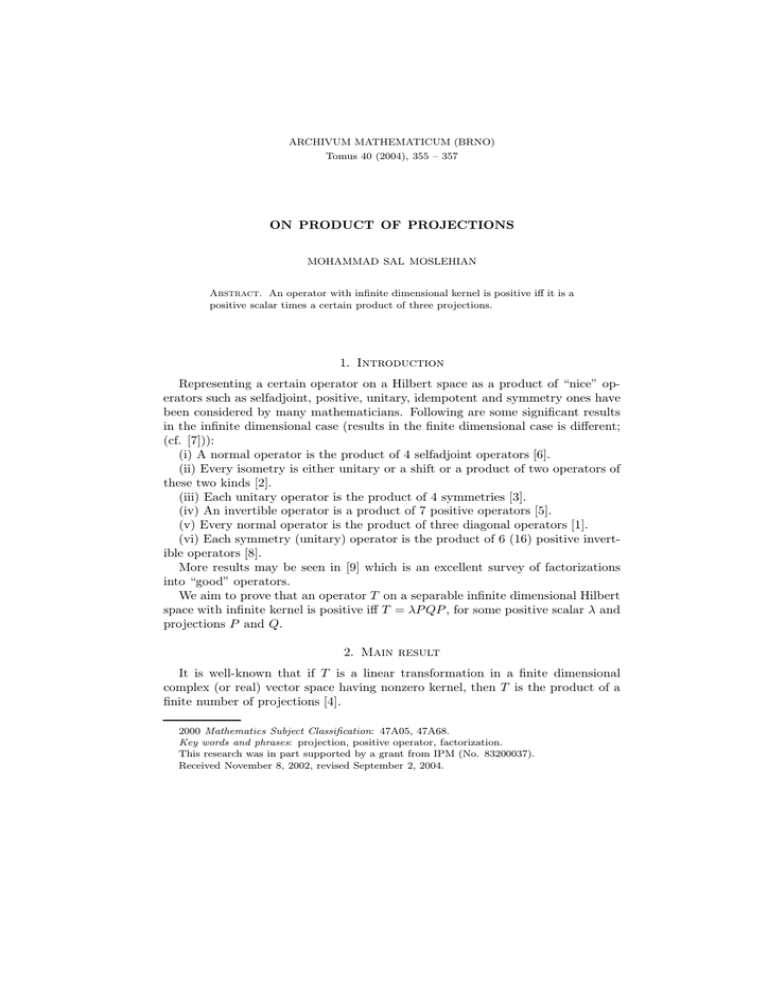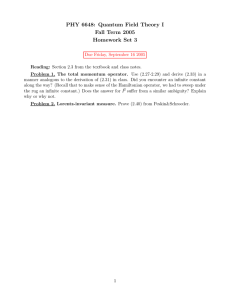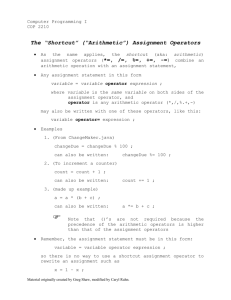ON PRODUCT OF PROJECTIONS
advertisement

ARCHIVUM MATHEMATICUM (BRNO)
Tomus 40 (2004), 355 – 357
ON PRODUCT OF PROJECTIONS
MOHAMMAD SAL MOSLEHIAN
Abstract. An operator with infinite dimensional kernel is positive iff it is a
positive scalar times a certain product of three projections.
1. Introduction
Representing a certain operator on a Hilbert space as a product of “nice” operators such as selfadjoint, positive, unitary, idempotent and symmetry ones have
been considered by many mathematicians. Following are some significant results
in the infinite dimensional case (results in the finite dimensional case is different;
(cf. [7])):
(i) A normal operator is the product of 4 selfadjoint operators [6].
(ii) Every isometry is either unitary or a shift or a product of two operators of
these two kinds [2].
(iii) Each unitary operator is the product of 4 symmetries [3].
(iv) An invertible operator is a product of 7 positive operators [5].
(v) Every normal operator is the product of three diagonal operators [1].
(vi) Each symmetry (unitary) operator is the product of 6 (16) positive invertible operators [8].
More results may be seen in [9] which is an excellent survey of factorizations
into “good” operators.
We aim to prove that an operator T on a separable infinite dimensional Hilbert
space with infinite kernel is positive iff T = λP QP , for some positive scalar λ and
projections P and Q.
2. Main result
It is well-known that if T is a linear transformation in a finite dimensional
complex (or real) vector space having nonzero kernel, then T is the product of a
finite number of projections [4].
2000 Mathematics Subject Classification: 47A05, 47A68.
Key words and phrases: projection, positive operator, factorization.
This research was in part supported by a grant from IPM (No. 83200037).
Received November 8, 2002, revised September 2, 2004.
356
M. S. MOSLEHIAN
Let’s now T be an operator acting on a separable infinite dimensional Hilbert
space H with infinite null space H◦ . If {ξ1 , ξ2 , · · · } is an orthonormal basis of H◦ ,
it can be extended to an orthonormal basis for H. If K is the closed linear span
of {ξ2 , ξ4 , ξ6 , · · · }, then obviously dim K = dim K ⊥ .
Suppose now V is a unitary from K ⊥ onto K and W is the unitary from
H = K ⊕ K ⊥ onto K ⊕ K defined
by W (y ⊕ z) = y ⊕ V z. The operator W T W ∗
0 R
could then be represented by
on K ⊕ K. Let’s identify T to W T W ∗ .
0 S
0 0
If T is positive, then R = 0 and so T =
. Moreover 0 ≤ S1 = kTS k ≤ I.
0 S
1 I − S1
(S1 − S12 ) 2
=Q
Applying functional calculus, we can show that
1
(S1 − S12 ) 2
S1
is a projection. It follows from
0 0
0 S
=kT k
0 0
0 I
I − S1
1
(S1 − S12 ) 2
1
(S1 − S12 ) 2
S1
0 0
0 I
we concludethat T =
k T k P QP is a positive scalar times a product of projections
0 0
Q and P =
.
0 I
Conversely, if T = λP QP , for some positive scalar λ and projections P and Q,
then for η ∈ H,hT η, ηi = λhQP η, QP ηi ≥ 0. Hence T is positive.
In the finite dimensional case H = C2 , however, the fact that T =k T k P QP
1 0
.
implies that det(T ) =k T k2 det(P )2 det(Q) which is not true for T =
0 2
Remark. Thanking Pei Yuan Wu, we note that an operator T is expressible
as P QP for some projections P and Q if and only if T is the direct some of the
identity operator (on some space K) and a positive contraction A on L with nullity
at least one half of the dimension of L.
References
[1] Fong, C. K. and Wu, P. Y., Diagonal operators: dilation, sum and product, Acta Sci. Math.
(Szeged) 57 (1993), No. 1-4, 125–138.
[2] Halmos, P. R., Products of shifts, Duke Math. J. 39 (1972), 779–787.
[3] Halmos, P. R. and Kakutani, S., Products of symmetries, Bull. Amer. Math. Soc. 64 (1958),
77–78.
[4] Hawkins, J. B. and Kammerer, W. J., A class of linear transformations which can be written
as the product of projections, Proc. Amer. Math. Soc. 19 (1968), 739–745.
[5] Phillips, N. C., Every invertible Hilbert space operator is a product of seven positive operators, Canad. Math. Bull. 38 (1995), no. 2, 230–236.
[6] Radjavi, H., On self-adjoint factorization of operators, Canad. J. Math. 21 (1969), 1421–
1426.
[7] Radjavi, H., Products of hermitian matrices and symmetries, Proc. Amer. Math. Soc. 21
(1969), 369–372; 26 (1970), 701.
ON PRODUCT OF PROJECTIONS
[8] Wu, P. Y., Product of normal operators, Canad. J. Math. XL, No 6 (1988), 1322–1330.
[9] Wu, P. Y., The operator factorization problems, Lin. Appl. 117 (1989), 35–63.
Department of Mathematics, Ferdowsi University of Mashhad
P. O. Box 1159, Mashhad 91775, Iran
and
Institute for Studies in Theoretical Physics and Mathematics (IPM), Iran
E-mail: msalm@math.um.ac.ir
357







